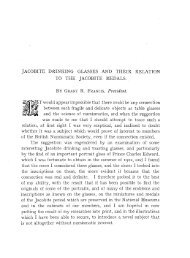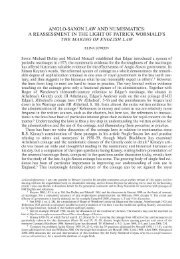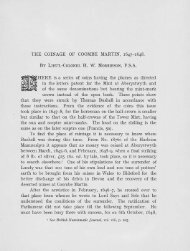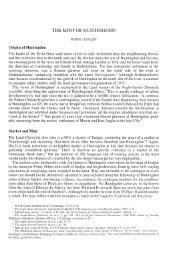a re-examination of a gold medal awarded to major rogers for ...
a re-examination of a gold medal awarded to major rogers for ...
a re-examination of a gold medal awarded to major rogers for ...
Create successful ePaper yourself
Turn your PDF publications into a flip-book with our unique Google optimized e-Paper software.
GOLD MEDAL AWARDED TO MAJOR ROGERS 139<br />
At Platin House, halfway between Dono<strong>re</strong> and Duleek, General Hamil<strong>to</strong>n had drawn up a body <strong>of</strong><br />
Irish cavalry in a field, in<strong>to</strong> which a gap from a by-road was the only entrance. Eight troops <strong>of</strong> Enniskilleners<br />
under Wolseley came riding along this by-road in advance <strong>of</strong> the army, and two troops<br />
promptly ente<strong>re</strong>d the field. Wolseley orde<strong>re</strong>d the men, by mistake, <strong>to</strong> <strong>for</strong>m <strong>to</strong> the right, thus bringing<br />
the men with their backs <strong>to</strong> the enemy. Orders <strong>to</strong> wheel <strong>to</strong> the right we<strong>re</strong> given, but the <strong>re</strong>sult was<br />
confusion. The Irish charged, and cutting down some fifty troopers, drove the others pell mell on <strong>to</strong> the<br />
crowded troops in the lane, who we<strong>re</strong> quite incapable <strong>of</strong> <strong>re</strong>sistance and we<strong>re</strong> chased out <strong>of</strong> the lane.<br />
FIG. 2.<br />
As the<strong>re</strong> has been a g<strong>re</strong>at inc<strong>re</strong>ase in the number <strong>of</strong> <strong>medal</strong> collec<strong>to</strong>rs in <strong>re</strong>cent years<br />
perhaps the following mo<strong>re</strong> detailed appraisal <strong>of</strong> this <strong>medal</strong> would be <strong>of</strong> inte<strong>re</strong>st. This<br />
<strong>medal</strong> is mo<strong>re</strong>over <strong>of</strong> importance in so far as, if authentic, it is one <strong>of</strong> the earliest <strong>of</strong><br />
British War Medals and possibly the earliest named <strong>medal</strong>. It could also be <strong>re</strong>garded<br />
as the ances<strong>to</strong>r <strong>of</strong> the engraved <strong>re</strong>gimental <strong>medal</strong> <strong>of</strong> the period 1790-1815, a class <strong>medal</strong><br />
highly prized both by private collec<strong>to</strong>rs and by <strong>re</strong>gimental museums. It is important<br />
the<strong>re</strong>fo<strong>re</strong> befo<strong>re</strong> it is <strong>re</strong>garded as authentic and used as a <strong>to</strong>uchs<strong>to</strong>ne <strong>to</strong> judge other<br />
<strong>medal</strong>s that it be subjected <strong>to</strong> a thorough <strong>examination</strong>.<br />
Obverse. Bust, lau<strong>re</strong>ated, <strong>to</strong> right. Legend, WILLIAM THE III: D (?) GR: REX: FID: DEF:<br />
1690.<br />
Going on the assumption that this <strong>medal</strong> is a product <strong>of</strong> the last decade <strong>of</strong> the seventeenth<br />
century we a<strong>re</strong> faced with a number <strong>of</strong> inconsistencies. First, the method <strong>of</strong><br />
manufactu<strong>re</strong> is not a usual one <strong>for</strong> the period. The <strong>medal</strong>s <strong>of</strong> the period up <strong>to</strong> about<br />
1650 a<strong>re</strong> either cast or made by hammering thin plates <strong>of</strong> metal in<strong>to</strong> a mould. These<br />
methods we<strong>re</strong> used <strong>to</strong> by-pass the difficulty <strong>of</strong> striking by the usual dies, as the art <strong>of</strong><br />
making dies and the imperfect machinery employed did not allow the use <strong>of</strong> high <strong>re</strong>lief.<br />
After the mid-seventeenth century the improvements in die manufactu<strong>re</strong> enabled the<br />
mo<strong>re</strong> economical and speedy modern method <strong>to</strong> be applied and so the casting or hammering<br />
<strong>of</strong> thin plates in<strong>to</strong> a mould, or <strong>re</strong>pousse as it is called, became obsolete. The<br />
workmanship <strong>of</strong> the <strong>medal</strong> in question is so poor that it is impossible <strong>to</strong> attribute it <strong>to</strong><br />
any <strong>of</strong> the fo<strong>re</strong>most <strong>medal</strong>lists <strong>of</strong> the period and the <strong>medal</strong> must be a copy <strong>of</strong> the work<br />
<strong>of</strong> one <strong>of</strong> them. The bust approaches most nearly <strong>to</strong> that used by Johannes Smeltzing<br />
in 1690 alluding <strong>to</strong> the calming down <strong>of</strong> the Dutch discontents in Amsterdam (Fig. 2).



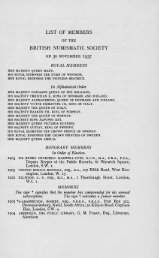

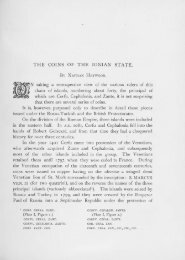
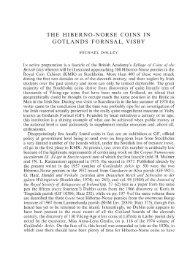
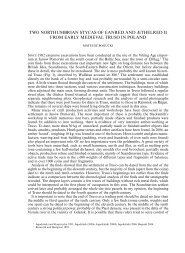

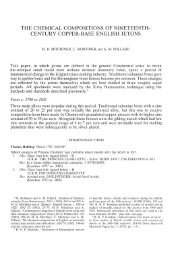
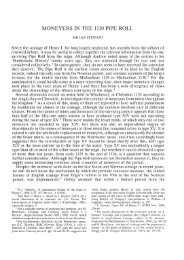
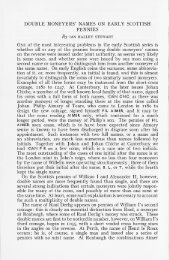
![Two Anglo-Saxon notes: [1] A Cnut die-link between the mints of ...](https://img.yumpu.com/15433998/1/189x260/two-anglo-saxon-notes-1-a-cnut-die-link-between-the-mints-of-.jpg?quality=85)
